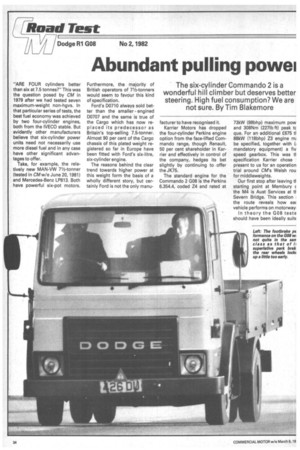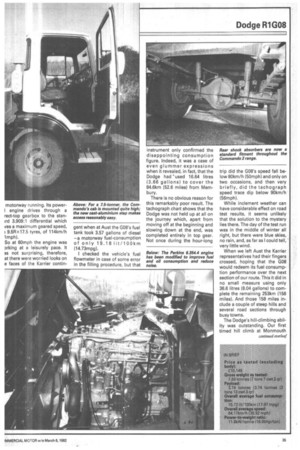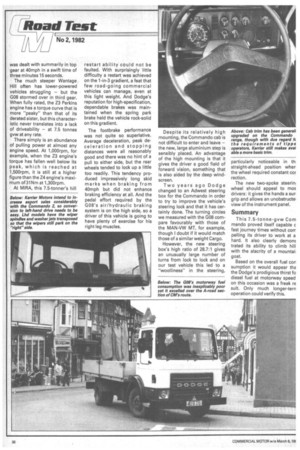Abundant pulling powei
Page 26

Page 27

Page 28

If you've noticed an error in this article please click here to report it so we can fix it.
"ARE FOUR cylinders better than six at 7.5 tonnes?" This was the question posed by CM in 1979 after we had tested seven maximum-weight non-hgvs. In that particular series of tests, the best fuel economy was achieved by two four-cylinder engines, both from the IVECO stable, But evidently other manufacturers believe that six-cylinder power units need not necessarily use more diesel fuel and in any case have other significant advantages to offer.
Take, for example, the relatively new MAN-VW 71/2-tonner (tested in CM w/e June 20, 1981) and Mercedes-Benz LP813. Both have powerful six-pot motors.
Furthermore, the majority of British operators of 71/2-tonners would seem to favour this kind of specification.
Ford's D0710 always sold better than the smaller engined D0707 and the same is true of the Cargo which has now replaced its predecessor as Britain's top-selling 7.5-tonner. Almost 90 per cent of the Cargo chassis of this plated weight registered so far in Europe have been fitted with Ford's six-litre, six-cylinder engine.
The reasons behind the clear trend towards higher power at this weight form the basis of a wholly different story, but certainly Ford is not the only manu
facturer to have recognised it.
Karrier Motors has dropped the four-cylinder Perkins engine option from the face-lifted Commando range, though Renault, 50 per cent shareholder in Karrier and effectively in control of the company, hedges its bet slightly by continuing to offer the JK75.
The standard engine for the Commando 2 G08 is the Perkins 6.354.4, coded Z4 and rated at
73kW (98bhp) maximum pow and 308Nm (2271b ft) peak tc que. For an additional £675 ti 88kW (118bhp) 13 engine rm be specified, together with (, mandatory equipment) a fiv speed gearbox. This was ti specification Karrier chose present to us for an operation trial around CM's Welsh rou for middleweights.
Our first stop after leaving ti starting point at Membury the M4 is Aust Services at tl Severn Bridge. This section the route reveals how eac vehicle performs on motorway In theory the 008 teste should have been ideally suitt motorway running. Its power! engine drives through a rect-top gearbox to the stenird 3.909:1 differential which ves a maximum geared speed, 9.5Rx 17.5 tyres, of 114km/h 1mph).
So at 60mph the engine was orking at a leisurely pace. It as not surprising, therefore, at there were worried looks on e faces of the Karrier contin gent when at Aust the G08's fuel tank took 3.57 gallons of diesel -a motorway fuel-consumption of only 1 9.1 8 lit/1 0 0 km (14.73mpg).
I checked the vehicle's fuel flowmeter in case of some error in the filling procedure, but that instrument only confirmed the disappointing consumption figure. Indeed, it was a case of even glummer expressions when it revealed, in fact, that the Dodge had 'used 16.64 litres 3.66 gallons) to cover the 84.6km (52.6 miles) from Membury.
There is no obvious reason for this remarkably poor result. The tachograph chart shows that the Dodge was not held up at all on the journey which, apart from moving off at the beginning and slowing down at the end, was completed entirely in top gear. Not once during the hour-long trip did the G08's speed fall below 80km/h (50mph) and only on two occasions, and then very briefly, did the tachograph speed trace dip below 90km/h (56mph).
While inclement weather can have considerable effect on road test results, it seems unlikely that the solution to the mystery lies there. The day of the test run was in the middle of winter all right, but there were blue skies, no rain, and, as far as I could tell, ' very little wind.
When we left Aust the Karrier representatives had their fingers crossed, hoping that the G08 would redeem its fuel consumption performance over the next section of our route. This it did in no small measure using only 36.6 litres (8.04 gallons) to complete the remaining 253km (158 miles). And those 158 miles include a couple of steep hills and several road sections through busy towns.
The Dodge's hill-climbing ability was outstanding. Our first timed hill climb at Monmouth was dealt with summarily in top gear at 40mph in a swift time of three minutes 15 seconds.
The much steeper Wantage Hill often has lower-powered vehicles struggling — but the G08 stormed over in third gear. When fully rated, the Z3 Perkins engine has a torque curve that is more "peaky" than that of its derated sister, but this characteristic never translates into a lack of driveability — at 7.5 tonnes gvw at any rate.
There simply is an abundance of pulling power at almost any engine speed. At 1,000rpm, for example, when the Z3 engine's torque has fallen well below its peak, which is reached at 1,500rpm, it is still at a higher figure than the Z4 engine's maximum of 31N m at 1,300rpm.
At MIRA, this 7.5-tonner's hill restart ability could not be faulted. With surprisingly little difficulty a restart was achieved on the 1-in-3 gradient, a feat that few road-going commercial vehicles can manage, even at this light weight. And Dodge's reputation for high-specification, dependable brakes was maintained when the spring park brake held the vehicle rock-solid on this gradient.
The footbrake performance was not quite so superlative. Average deceleration, peak deceleration and stopping distances were all reasonably good and there was no hint of a pull to either side, but the rear wheels tended to lock up a little too readily. This tendency produced impressively long skid marks when braking from 40mph but did not enhance braking efficiency at all. And the pedal effort required by the G08's air/hydraulic braking system is on the high side, so a driver of this vehicle is going to have plenty of exercise for his right leg muscles. Despite its relatively high mounting, the Commando cab is not difficult to enter and leave — the new, large aluminium step is sensibly placed. An advantage of the high mounting is that it gives the driver a good field of forward vision, something that is also aided by the deep windscreen.
Two years ago Dodge changed to an Adwest steering box for the Commando in order to try to improve the vehicle's steering lock and that it has certainly done. The turning circles we measured with the G08 compare favourably with those of the MAN-VW MT, for example, though I doubt if it would match those of a similar weight Cargo.
However, the new steering box's high ratio of 28.7:1 gives an unusually large number of turns from lock to lock and on our test vehicle this led to a "woolliness" in the steering, particularly noticeable in th straight-ahead position wher the wheel required constant cot rection.
The new two-spoke steerinl wheel should appeal to MOE drivers: it gives the hands a sur grip and allows an unobstructel view of the instrument panel.
Summary
This 7.5-tonne-gvw Corn mando proved itself capable c fast journey times without corr pelling its driver to work at a hard. It also clearly demon; trated its ability to climb hill with the alacrity of a mountaii goat.
Based on the overall fuel con sumption it would appear tha the Dodge's prodigious thirst fo diesel fuel at motorway speed on this occasion was a freak re suit. Only much longer-tern operation could verify this.
































































